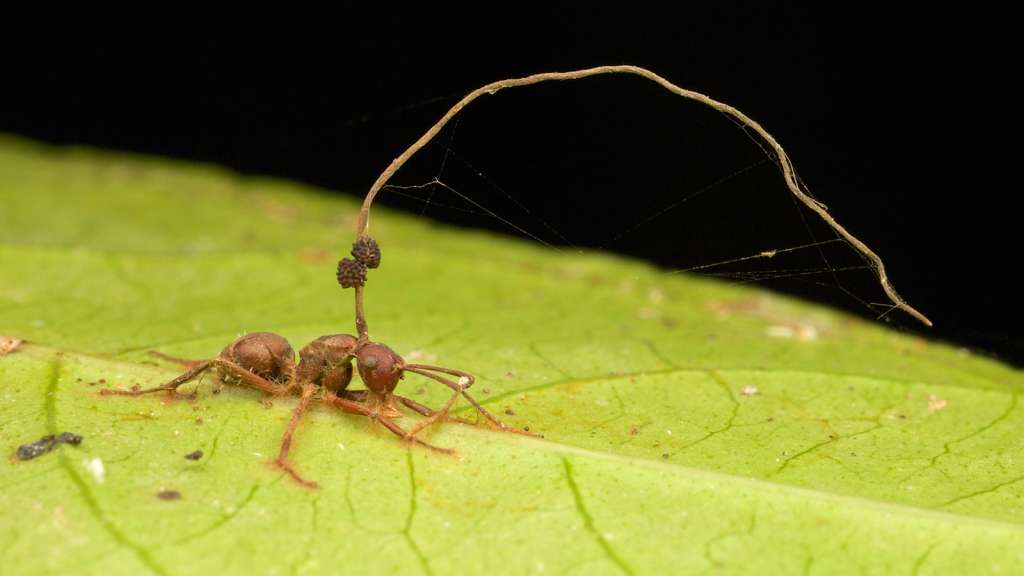(CNN) — The zombies are identifiable by the fungi bursting from their bodies: a thicket of spiky tendrils, a miniature garden of mushroom-like fruiting bodies. These fungal parasites act as puppeteers, commanding and positioning the zombies to infect entire communities.
It’s the premise of “The Last of Us,” a video game series and now a show on HBO, which shares parent company Warner Bros. Discovery with CNN, but it’s also a scene that plays out in real life every day around the world.
Are zombie fungi real?
The creators of “The Last of Us” have said they were inspired by a sequence in BBC’s “Planet Earth” documentary series depicting an ant infected with a fungus that hijacks its brain, forcing it to climb a tree and dangle above the forest floor. There, the fungus digests the ant’s body from the inside out and unleashes a shower of spores to create more zombies.
When “Planet Earth” came out in 2006, the zombie ant fungus was believed to be part of the group Cordyceps, but genetic studies have since placed it in another insect-parasitizing fungus group, Ophiocordyceps.
There are well over 100 known Ophiocordyceps species that infect a wide variety of insects, including butterflies, moths and beetles, and at least 35 that perform “mind control” on their hosts.
“We only know 35, but our estimates range to more than 600 species, waiting to be described,” said João Araújo, an assistant curator of mycology at the Institute of Systematic Botany of the New York Botanical Garden.
Can fungi infect and control humans?
While zombie fungi are real and numerous, Araújo and others aren’t worried about Ophiocordyceps infecting people.
“They’re super species-specific,” said Charissa de Bekker, an assistant professor in the biology department at Utrecht University in the Netherlands.
Each of the known Ophiocordyceps species preys upon a particular insect, and that specificity is a double-edged sword. “They have very refined machinery to interact with their hosts and do these really interesting things like changing behavior, but they can’t even jump from one species to the next,” let alone to an organism as distantly related as a human, de Bekker explained.
Humans’ immunity to Ophiocordyceps is evident in how many interactions with the fungi have so far proved harmless. People in parts of Asia use one type (Ophiocordyceps sinensis) in traditional medicines, and scientists who study the fungi haven’t been infected.
“I inhale Ophiocordyceps spores all the time because I work with them closely,” said Araújo, who remains un-zombified.
While we may be safe from Ophiocordyceps, David Hughes, one of the scientists who consulted on the video game, said there is a lesson to be learned from the “The Last of Us,” which is essentially a story about existential threats to humanity.
“The biggest threat globally is climate change,” said Hughes, who has shifted his research focus away from zombie ants and is now Dorothy Foehr Huck and J. Lloyd Huck Chair in Global Food Security at Pennsylvania State University.
Fungal disease and climate change
“The Last of Us” raises the point that climate change could spur on fungal adaptations to hotter habitats. That’s true of the infectious fungus Candida auris, which was discovered in 2009 and has since been found in more than 30 countries.
“In a warming world, fungi also have to adapt to a warmer climate,” de Bekker said. “And you can imagine then, if their optimal growth temperatures therefore become higher and closer to our body temperatures, it might be more likely that in the future, we have more fungal infections in humans than we see right now.”
A widespread fungal pandemic is unlikely, based on how fungal infections tend to spread in humans, according to Dimitrios Kontoyiannis, deputy head in the division of internal medicine at the University of Texas MD Anderson Cancer Center and the leader of its Medical Mycology Research Center.
However, Kontoyiannis noted that fungal diseases are harder to treat than bacterial infections because fungi, like humans, are made of eukaryotic cells and share the same basic cell structures. This makes it very difficult to find a treatment “that targets the fungus and not the humans,” he said.
A warmer future with more fungal infections would especially endanger people with weakened immune systems, Kontoyiannis added.
Hughes said he hopes people who engage with “The Last of Us” see the parallels to the real-life challenges facing our world, including climate change and new health threats that will accompany it. “The whole thing is a real-time study in what we pay attention to and what we act on,” he said.

